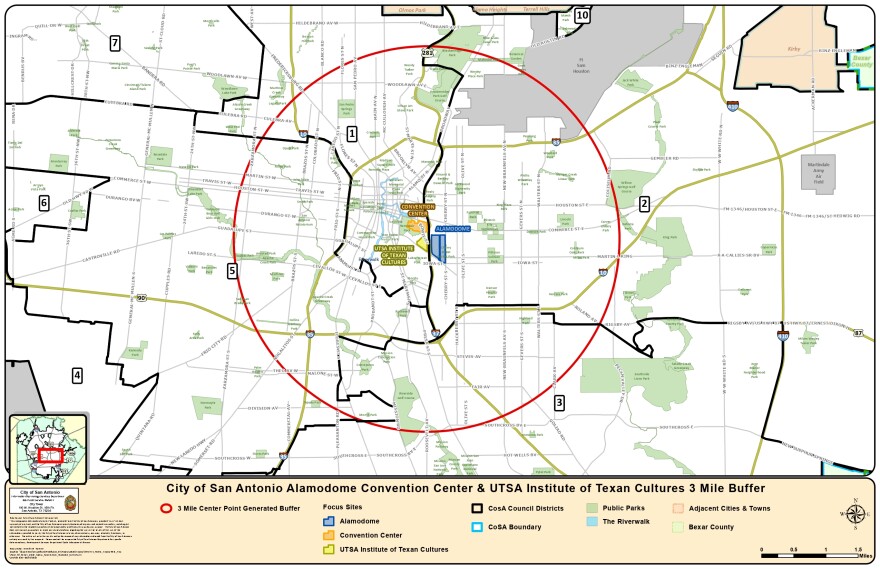Sign up for TPR Today, Texas Public Radio's newsletter that brings our top stories to your inbox each morning.
The San Antonio City Council will vote on the creation of a special tax zone on Thursday that could be a major source of funding for a new downtown Spurs arena that could cost as much as $1.5 billion.
The Project Finance Zone (PFZ) is a tax mechanism the state legislature allowed San Antonio to establish in 2023. The PFZ is a three-mile area where the city can use some state hotel tax revenues for 30 years for approved convention center or venue projects.
In this case, the council will vote on creating a PFZ for the “Convention Center Complex” project, which includes the Spurs arena along with major upgrades to the Henry B. Gonzalez Convention Center and Alamodome. All three are part of Project Marvel, the city’s planned Sports & Entertainment District.

The PFZ is projected to generate around $2.5 billion over its 30-year lifespan.
San Antonio’s Chief Financial Officer Ben Gorzell emphasized that the city wouldn’t get its hands on most of that money for a long time.
“We've talked about how this zone is incremental revenue,” he said. “So it starts small, a couple million dollars a year, and then grows over time.”
The PFZ — and other development tax zones like Tax Increment Reinvestment Zones (TIRZ) — operate based on the incremental growth in tax revenue in a certain geographic area starting from a “base year” of revenue. In this case, 2025 would act as the “base year” for hotel tax revenues within the PFZ.
Any hotel tax revenues above this year’s figures over the next 30 years starting in 2026 will be held by the Texas Comptroller to be rebated to the city to pay for the projects; if any year dips below 2025’s hotel tax revenue for the area, no money will be put aside.
The PFZ would not add any additional taxes to the hotels or other businesses and residents in the area. But the new PFZ would divert public money that would otherwise go to the state to support development for the Spurs, along with the city-owned Convention Center and Alamodome.
City Manager Erik Walsh explained the city’s rationale.
“It's public dollars, but it's dedicated within that zone,” he said. “So in other words, development paying for development within that area.”
Which entity — Bexar County, San Antonio, the Spurs, or some combination — will eventually own the new Spurs arena has not been finalized.
Gorzell explained that the city would use PFZ revenue to pay for debt service on bonds the city will issue and as coverage for those bonds.
Gorzell and Walsh said money from the PFZ was just one of five funding mechanisms the city is weighing for the Spurs arena: the Bexar County venue tax, Spurs private funding, money from the Hemisfair TIRZ, the PFZ, and Spurs team revenue.
And the Spurs arena is not the priority for funding from the PFZ.
“We're in line with what we presented before, [the] Convention Center is priority,” Gorzell said. “The [Spurs] arena could be in that short term window, the [Alamodome] — we had talked about — we've kind of pushed out the more significant renovation of the [Alamodome], probably out 10 years or so.”
Gorzell said Alamodome upgrades had been pushed back because upgrades for it and the Convention Center were estimated to cost over $1 billion each, not because of the inclusion of the new Spurs arena in the PFZ.
“We don't have enough resources to do both of those projects in the next couple of years,” he said. “So out of those two, the priority is to get the Convention Center done, those two being the Convention Center [and] the Alamodome. So our timing isn't changing. This is really just resizing this PFZ, from a timing perspective, to give us flexibility.”

Some of that flexibility comes because of how the state law that authorizes San Antonio to use PFZs is written. It requires the city to begin construction on the project within five years of the PFZ’s creation — if either the Spurs arena, Convention Center, or Alamodome start construction in the next five years, the city gets to use the money for all three projects, even if one or two don’t start construction until after that five-year window.
City officials first informed the city council about the Alamodome upgrades taking 10 years or more to complete back in November.
In order to create the new PFZ, the city council will also vote on Thursday to dissolve the current PFZ, which has only the Convention Center and Alamodome listed as qualifying projects which could receive money. The council created that PFZ in 2023.
All revenue generated so far from that initial PFZ will be returned to the state.
Fort Worth and Dallas were the first cities allowed to create PFZs in 2013; San Antonio, Houston, and Corpus Christi have gained the authority to do so in the last several years. The result will be billions of state dollars being redirected to fund specific city convention center and venue projects over the next several decades.




